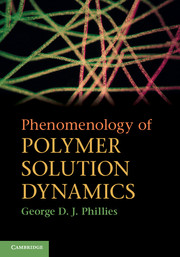Book contents
- Frontmatter
- Contents
- Preface
- 1 Introduction
- 2 Sedimentation
- 3 Electrophoresis
- 4 Quasielastic light scattering and diffusion
- 5 Solvent and small-molecule motion
- 6 Segmental diffusion
- 7 Dielectric relaxation and chain dimensions
- 8 Self- and tracer diffusion
- 9 Probe diffusion
- 10 Dynamics of colloids
- 11 The dynamic structure factor
- 12 Viscosity
- 13 Viscoelasticity
- 14 Nonlinear viscoelastic phenomena
- 15 Qualitative summary
- 16 Phenomenology
- 17 Afterword: hydrodynamic scaling model for polymer dynamics
- Index
- References
1 - Introduction
Published online by Cambridge University Press: 05 August 2012
- Frontmatter
- Contents
- Preface
- 1 Introduction
- 2 Sedimentation
- 3 Electrophoresis
- 4 Quasielastic light scattering and diffusion
- 5 Solvent and small-molecule motion
- 6 Segmental diffusion
- 7 Dielectric relaxation and chain dimensions
- 8 Self- and tracer diffusion
- 9 Probe diffusion
- 10 Dynamics of colloids
- 11 The dynamic structure factor
- 12 Viscosity
- 13 Viscoelasticity
- 14 Nonlinear viscoelastic phenomena
- 15 Qualitative summary
- 16 Phenomenology
- 17 Afterword: hydrodynamic scaling model for polymer dynamics
- Index
- References
Summary
This volume presents a systematic analysis of experimental studies on the dynamics of polymers in solution. I cover not only classical methods, e.g., rheology, and more modern techniques, e.g., self-diffusion, optical probe diffusion, but also radically innovative methods not generally recognized as giving information on polymer dynamics, e.g., capillary zone electrophoresis. Actual knowledge comes from experiment. The intent is to allow the data to speak for themselves, not to force them into a particular theoretical model in which they do not fit; freed of the Procrustean bed of model-driven analysis, the data do speak, loudly and clearly.
The Phenomenology examines what we actually know about polymer motion in solution. The objective has been to include every significant physical property and experimental method, and what each method shows about polymer motion. The list of methods includes several that have not heretofore been widely recognized as revealing the dynamics of polymer solutions. Undoubtedly there are omissions and oversights, for which I apologize. The reader will note occasional discussions that speak to particular models, but experiment comes first, while comparison with various hypotheses is postponed.
The following dozen chapters demonstrate that the vast majority of measurements on polymer dynamics can be reduced to a very modest number of parameters. These parameters have simple relationships with underlying polymer properties such as polymer molecular weight. The relationships in turn speak to the validity of several possiblemodels for polymer dynamics, models whose validity is also tested by a number of more qualitative observations on how polymers move in solution.
- Type
- Chapter
- Information
- Phenomenology of Polymer Solution Dynamics , pp. 1 - 9Publisher: Cambridge University PressPrint publication year: 2011



